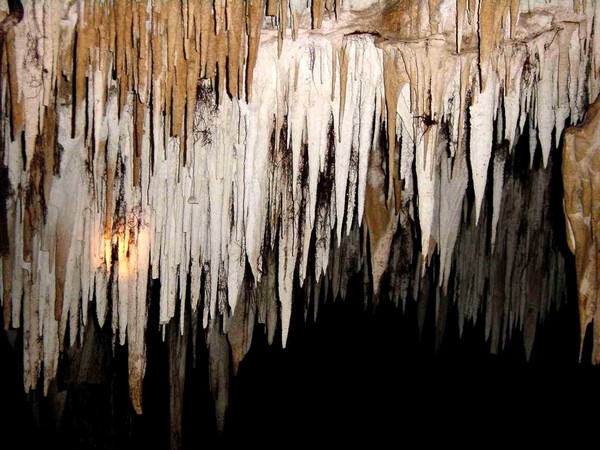Come si formano le stalattiti? E le stalagmiti?
Quando possiamo chiamare una stalattite, una colonna?
In questa grotta, cosa è successo riguardo il Proteus anguinus?
Quanto è profondo il lagghetto? (a occhio)
Sei riuscito a vedere una stalattite che si è unita ad una stalagmite (che formano quandi un'unica colonna)?
Entra nella grotta, stima quanto è lunga e quanto è larga.
Guarda la guida, come traina la barca?
(facoltativo) Scatta una foto di te nei pressi del GZ :)
ATTENZIONE
Il tour non è disponibile ogni giorno e l'ingresso è a pagamento. Prezzi e orari CLICCA QUI
LE GROTTE DI OLIERO
Located in the valley of the Brenta, in the municipality of Valstagna, the sources Oliero are among the largest karst springs in Europe and tourist destination of national interest.
From the caves originate the headwaters of the river Oliero, which are considered among the most important sources valchiusane Europe. The cave-source Oliero is the most abundant source of Veneto, pouring about 8 million cubic meters of water a day.
The outlets, called in the local dialect "covoli", are four: two are dry (the covolo killers or Ezzelini and covolo of Soree, sisters) and two are existing outlets to the river. The main of these two (the covolo of Siori, gentlemen, or cave Parolini) can be accessed by boat inside the caves themselves. The cave Parolini, which takes its name from the naturalist Alberto Parolini who discovered it in 1822, is open to the public since 1832. The trap source has been explored for about 2.5 km on the eight estimates. It seems to be one of the longest in Italy.
The cave "covers" a pond, in fact to exceed the cave requires a boat.
The water and air temperature inside the cave is almost constant throughout the year. Among the features of the cave there are stalactites and stalagmite limestone which a length of about 14 meters (whose formation took 40,000 years!).
FAUNA
In 1832 Parolini (the owner of the area) explored the cave, you introduced - taking it from Postojna (Slovenia) - Proteus anguinus, amphibian caveman very slow and blind, long about 15 cm., with pink and fitted permanently to the gills. For over a century and a half it was thought that the experiment had failed, and the same Brentari wrote that died. Instead, in 1965, the Group Speleo-Hydrological Friulano he spotted some specimens in the underground sections of both the Covol Siori in that of Veci, sightings then repeated periodically for many cave divers.
Before starting the tour is a good idea to know some thing:
PAY ATTENTION TO THE WORDS, OR STALATTITE STALAGMITE?
Stalactite (hangs another):

Stalagmite (risale dal pavimento):
 HOW ARE BEING FORMED STALACTITES?
The stalactite is a limestone formation hanging from the top of the caves subject to karst phenomena.
HOW ARE BEING FORMED STALACTITES?
The stalactite is a limestone formation hanging from the top of the caves subject to karst phenomena.
Is formed as a result of the continuous and prolonged mineral deposits transported by the water percolating in the cave, in particular of calcium bicarbonate which then precipitates as calcium carbonate that is deposited and thus forms the stalactite.
The stalactite generally has a cylindrical or cone-stretched, but if the cave is covered by air currents can deviate from its vertical axis and assume bizarre shapes.
When a stalactite joins a stalagmite is formed of a column.
The formation of large stalactites requires long times, even of the order of thousands of years. A curiosity is constituted by an initial form of stalactite, the cannula, which presents itself as a translucent tube through which pass the water droplets. If the ceiling of the cave presents many, from the bottom one has the feeling of a cascade of spaghetti.
The name derives from the Greek word stalactite Σταλακτίτης (Stalaktites), with the meaning of dripping.
 AND STALAGMITES?
The stalagmites follow the same process of formation of stalactites but with the exception that the mineral deposits collect on the ground and not remain attached to the ceiling.
THE TOUR
The tour will begin with the entry of the cave by boat, since (as noted above) the entrance of the cave is covered with a pond, do not worry, the guide will take care of traghettarvi inside. But before you don a safety helmet that will be delivered. The guide will start illustravi all geological aspects of the cave, and just before the end of the cave, descend to the ground for a short ride to PIDI. The tour is suitable for people of all ages.
HOW TO DO THE CACHE LOG
AND STALAGMITES?
The stalagmites follow the same process of formation of stalactites but with the exception that the mineral deposits collect on the ground and not remain attached to the ceiling.
THE TOUR
The tour will begin with the entry of the cave by boat, since (as noted above) the entrance of the cave is covered with a pond, do not worry, the guide will take care of traghettarvi inside. But before you don a safety helmet that will be delivered. The guide will start illustravi all geological aspects of the cave, and just before the end of the cave, descend to the ground for a short ride to PIDI. The tour is suitable for people of all ages.
HOW TO DO THE CACHE LOG
To log the cache you will have to join the tour and answer these questions:
How are being formed stalactites? And stalagmites?
When we could call a stalactite a "column"?
In this cave , what happened about the Proteus anguinus ?
Enter the cave, it estimates how long and how wide.
How deep is the lake? (eye)
Were you able to see a stalactite that has joined a stalagmite (forming Quandi single column)?
View guide how he towing the boat?
(optional) Take a picture of yourself near the GZ :)